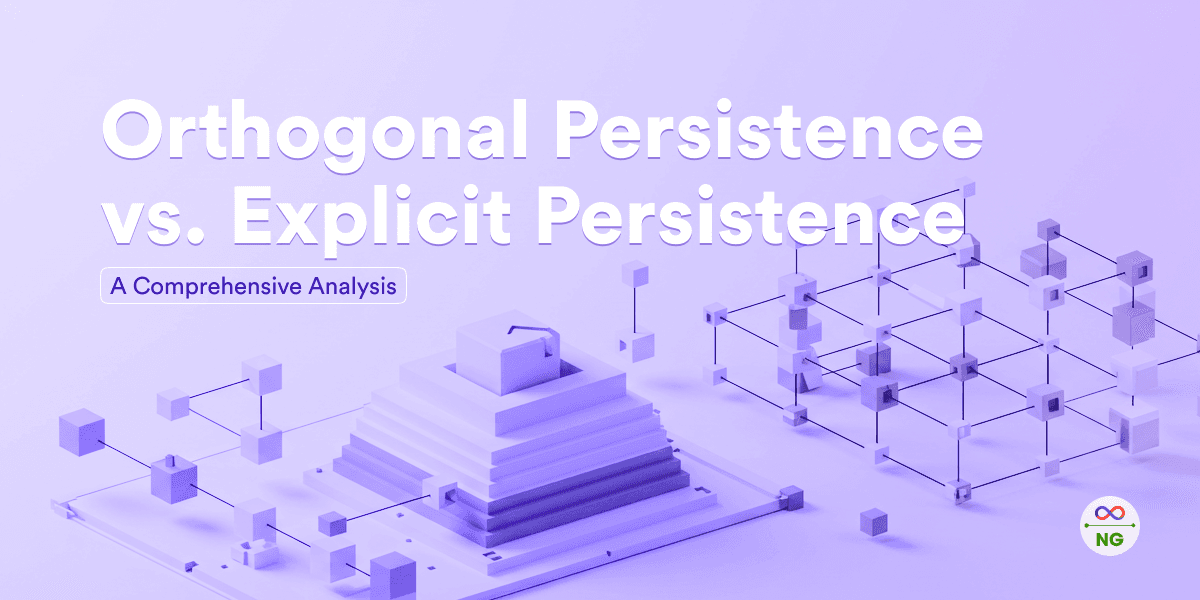
The Internet Computer (IC) works like a massive, decentralized computer that runs programs. Think of it as an operating system that isn’t tied to a single machine but instead runs across a network of computers.
ICP has many interesting features that help developers scale; one such feature of the IC is orthogonal (or “transparent”) persistence. In this article, we will learn the difference between Orthogonal Persistence and Explicit Persistence.
Orthogonal Persistence and Explicit Persistence represent two fundamentally different approaches to data management in software development. Understanding their differences is crucial for developers choosing between traditional and modern decentralized systems. The Internet Computer (IC) introduces orthogonal persistence as a core feature, contrasting sharply with explicit persistence, which requires manual state management.
The Complexity of Explicit Persistence
Explicit persistence has long been the standard approach in software development. Applications relying on this method must actively store and retrieve data using databases, file systems, or external storage solutions. This approach involves several key challenges:
- Storage management requires careful selection of data storage solutions such as relational or non-relational databases.
- State persistence demands additional logic for saving and retrieving data at appropriate points within an application’s lifecycle.
- System crashes pose risks, potentially leading to data loss if proper safeguards are not implemented.
- Performance optimization requires fine-tuning queries, indexing, and caching strategies to maintain efficiency.
Explicit persistence offers flexibility, allowing developers to structure data storage as needed. However, it comes with significant maintenance overhead, increased development time, and the necessity for extensive testing to prevent data corruption or loss.
The Advantage of Orthogonal Persistence on the Internet Computer
Orthogonal persistence eliminates the need for developers to handle explicit state management. The Internet Computer enables applications to maintain state across function calls, system upgrades, and even crashes without requiring additional intervention.
In a more simple term: Normally, when you run a program, it loses its data if the system crashes or restarts unless you manually save that data in a file or database. Orthogonal persistence means that the Internet Computer automatically remembers everything for you, even if the program stops running. You don’t need to write extra code to save or reload data—it just happens in the background. This makes programs feel like they never crash or lose information, making development much simpler.
This feature brings several benefits:
- State management is handled natively within canisters, the smart contract containers on the Internet Computer.
- Applications continue functioning as though they never terminate, with state seamlessly retained between invocations.
- Database dependencies are reduced as applications do not require external storage solutions to maintain persistence.
- Security and reliability improve since the risk of data loss due to manual persistence errors is eliminated.
This automated persistence model simplifies development, making it particularly advantageous for Web3 applications that demand reliability and continuity without centralized infrastructure. Canisters on the Internet Computer inherently store their state, making development more efficient while reducing operational complexity.
Comparing the Two Approaches
Explicit persistence allows control over data management but requires careful handling to ensure reliability, and also, the developer has to manually save and retrieve data using files, databases, or other storage solutions. If you forget to save, data could be lost when the program stops running.
Orthogonal persistence, in contrast, abstracts these concerns away, enabling a seamless developer experience where applications behave as if they are always running.
Traditional cloud applications often rely on explicit persistence through managed databases or object storage. The Internet Computer introduces a fundamentally different paradigm, where application logic and storage merge into a unified, self-sustaining execution environment.
Choosing the Right Model for Development
The choice between orthogonal and explicit persistence depends on the application’s needs. Systems requiring strict control over data storage formats and querying capabilities may still benefit from explicit persistence. However, applications that prioritize ease of development, fault tolerance, and reduced infrastructure dependencies gain significant advantages from orthogonal persistence on the Internet Computer.
As decentralized computing continues to evolve, solutions like orthogonal persistence redefine how developers approach state management, reducing complexity and enabling a more streamlined, resilient application architecture.
Article By: Mana Lamja